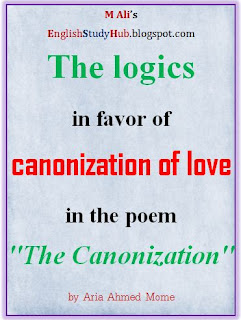The logics presented by the speaker in favor of canonization of their love in the poem ''The Canonization''
Canonization is the
act by which the Roman Catholic Church officially declares a dead man as a
saint. In John Donne's famous love-lyric ''The Canonization'', the
poet expresses his desire to be canonized or to be announced as the saint of
love through excellent conceits and imageries. The love of the poet and his
beloved is supreme and noble, they are models of love. So they will be
immortalized and honoured as the saints of love after their death. Though no
one will officially declare them to be canonized, he expects that they will be
canonized through their love lyrics and sonnets. The lovers are devoted to each
other as a saint is devoted to God. Thus, they are canonized by their
holy passion of love. The significance of the title of the poem is
exceptionally high. John Donne, who is considered to be the founder and leader
of the metaphysical school of poetry, has revealed his desire to become
legendary and immortal, through his love poems and lyrics. We find his utmost
intension has become fruitful. Even in this modern age, Donne's poems are
immensely popular among the readers. People study them, analyse them, think
over them and above all, follow them in real life. And in this way, the poet's
dream to be canonized or to be immortalized has become successful. Now let us
discuss the logics that Donne sets up to canonize their
love.
In ''The
Canonization'', Donne sets up a five-stanza argument to demonstrate the power
and purity of love between him and his beloved. Each stanza begins and ends
with the word ''love''. The very beginning of the poem shocks the reader with a
blow of astonishment-
For
God's sake hold your tongue, and let me love
The poet here
rebukes his friend who tries to discourage him from making love. He asks his
friend to shut his mouth and not to disturb him at his romantic moment. He can
attack the poet's gout or paralysis or baldness or his misfortune, but it will
be totally useless. Just in the same way it is equally futile for him to try to
dissuade the poet from love-making. The poet advises to the complainer that he
should turn his attention elsewhere. He suggests various ways in which his
friend might occupy himself. He should try to gain wealth and improve his condition;
or should try to concentrate his mind in acquiring knowledge and develop a
taste for art. He may try to occupy a position at the royal court and thereby
get a chance of observing the king in his true colours or he may try to make
money and thus see the king's image stamped on coins. He may do whatever he
likes but he should not interfere with the poet's love-making with his beloved.
In the
following stanza, the poet tells that nobody is hampered by their love-making. Here
the poet has given some fantastic hyperboles. The poet parodies contemporary
Petrarchan notions of love and continues to mock his addressee, making the
point that his sighs have not drowned ships and his tears have not caused
floods-
''Alas,
alas, who's injured by my love?
What
merchant's ships have my sighs drowned?
Who
says my tears have overflowed his ground?
The coldness of his
heart has not prolonged the winter season or slowed the arrival of spring. The
warmth of his passion has not increased the number of persons who die of plague.
His love will not keep soldiers from fighting wars or lawyers from finding
court cases. In spite of his love, the normal life of the world continues as
usual. By raising these arguments, the poet wants to say as no one is being
affected by his love affairs, so anyone should not make any objection.
In the third
stanza the speaker begins spinning off metaphors that will help explain the
intensity and uniqueness of his love. The friend can call the poet and his
beloved whatever he wishes, he can call them mad, but their madness is the
result of their love. They are like moths drawn to lights, then they are like
candles as they both burn themselves out in mutual love. They embody the
elements of the eagle(strong and masculine) and the dove (peaceful and
feminine). At the same time they are violent and gentle and prey on each other.
The poet then shifts to image of the Phoenix, another death-by-fire symbol. Donne
has used here the allusion of phoenix
riddle. Phoenix is a mythological bird in Greek
mythology which is monstrous and miraculous like dragon. This bird makes
a pyre after every 500 years and jumps into it and burns itself into ashes. Then
it takes rebirth from its ashes. So this bird is a symbol of immortality. It is
a bird of neutral sex. It is neither a male nor a female. It is a combination
of two sexes. Donne believes that his love with his beloved is immortal like
phoenix. At the same time he believes that their united soul is the combination
of two sexes. They form one being of unisex. It proves their inseparable bondage
and purified union-
The
phoenix riddle hath more wit
By
us; we two being one, are it.
[...]
We
die and rise the same, and prove
Mysterious
by this love.
The poet here shows
that even though their flames of passion will consume them, the poet and his
beloved will be reborn from the ashes of their love.
The fourth
stanza opens out to consider the legacy of the poet's love with his beloved. If
they cannot live together by their love, they can at least die by it. Their
love will endure in legend if they are considered unfit for grave and
funeral, the language of verse and chronicles will describe it. The glory of
their love would be remembered through lyrics and sonnets. When people will
hear these songs, they would regard them as hymns. Their love is self-contained
and perfect like a well-wrought urn. The ashes in this urn are meant to spread,
the tale of perfect love will be spread throughout the world.
The final
stanza voices the poet's sense of future vindication over the critic. The poet
expects that the rest of the world will invoke himself and his beloved, as
their love was supreme and holy. Love brought them peace of soul. The whole
world was present as they looked into each other's eyes. They served as mirrors
to each other, they could see their own reflection in each other. They are role
models of love for the world, because-
Countries,
towns, courts: beg from above
A pattern
of your love!
The lover's
legend has grown, and they have reached a kind of sainthod. Generations of
future lovers from all around the world will appeal for help to them, and
everyone will follow their pattern of love.
From the light
of above discussion, we can form an opinion that ''The Canonization'' is one of
Donne's most famous and most written-about poems.The poem shows the
craftsmanship of Donne at his best. The analogies and the imageries used in the
poem are the finest examples of Donne's
wits. The wish of the poet to be immortalized that he expresses through this
poem, has been fulfilled. Although he is a poet of 17th century, we are
studying and following his poems in our love affairs. So in this way, what
Donne expected, is proven true. The love of him and his beloved can never be
destroyed, it will be followed by people for generations, as they have been
canonized by their supremacy of love.




Comments
Post a Comment